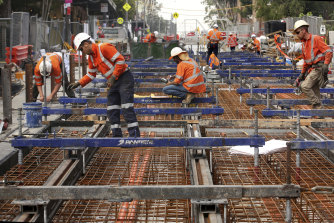A good New Year’s resolution for readers of the business pages would be to read more widely and think more broadly, so their thinking about economic problems and their solutions doesn’t get into a rut, returning repeatedly to the same old solutions to the same problems.
No reader of these pages needs to be told that the key to higher material living standards is improved productivity – the ability to create more outputs from the same quantity of inputs of land (raw materials), labour and physical and intangible capital.

Almost continuous productivity improvement over the past two centuries is the outstanding achievement of capitalist, market economies, the proof of capitalism’s superiority as a system of organising production and consumption.
It’s what’s made us so much more prosperous than our forebears were, with much of that prosperity spilling over from the owners of capital to the middle class and people near the bottom.
But, as I’m sure you know, over the past decade or so the rate of productivity improvement in Australia and all advanced economies has slowed to a snail’s pace. Hence, all the talk about productivity and what we can do improve its rate of improvement.
So far, a decade of hand-wringing hasn’t got us anywhere. We need to think more broadly about the problem.
One new thought is to wonder if there is – or should be – more to the good life than economic growth and a higher material standard of living. If there are ways we could improve the quality of our lives even if they didn’t lead to us owning more and better toys.
A negative way to express the same thought is to wonder if being able to afford better houses and cars will be much consolation if we succeed in stuffing up our climate, with more heat waves, rainy summers, droughts, bushfires, floods, cyclones and a rising sea level.
But we’ll return to those thoughts another day, and descend now to the more prosaic. One rut we’ve got into is thinking it’s up to the government to lift our productivity by “reforming” this or that intervention in the economy.
This is model-blind thinking of the part of econocrats, hijacked by rent-seeking businesses and high income-earners wanting more power to limit the earnings of their employees and more of the tax burden shifted to other people in the name of improving “incentives”.
The same people show little interest in reforms that really would increase economic growth by increasing women’s participation in paid work, such as free childcare.
Another rut we’re in is thinking that we won’t get faster economic growth until we get back to faster productivity improvement.
This has much truth, but it misses the deeper truth that the relationship between economic growth and productivity can also run the other way: maybe we’re not getting faster productivity improvement because we’re not getting enough economic growth.
In practice, what does much to increase the productivity of labour is businesses – in mining, farming and manufacturing, but also the service industries – replacing old machines with the latest, most improved models.
But business investment has long been at historically low levels, making our weak productivity performance hardly surprising. And the dearth of new investment spending is also hardly surprising considering consumer spending has been so weak for so long.
Nor is weak consumer spending surprising when you remember how weak the growth in real wages has been. One reason wage growth has been so weak, as Reserve Bank governor Dr Philip Lowe has pointed out, is the present fashion of businesses using any and every means – legal or otherwise – to limit labour costs and so increase profits. There are other paths to profitability.
While we’re thinking unfamiliar thoughts on the possible causes of our productivity plateau, remember this one: when businesses have been investing strongly in new equipment in the past, it’s often been a time when labour costs have been rising rapidly, giving them a strong incentive to invest in labour-saving machines.
(Note, it’s precisely because this increases the productivity of labour, and thus increases real national income, that the pursuit of labour saving simply shifts the demand for labour from goods-producing industries to services-producing industries, leaving no decline in the demand for labour overall.)
Last year some economists at the International Monetary Fund wrote a blog post on yet another contributor to weak productivity improvement, which will certainly come as a surprise to “Brother Stu,” federal Education Minister Stuart Robert, who late last month sent a “letter of expectations” to the government’s Australian Research Council outlining the Morrison government’s desire to prioritise short-term research jobs that service the interests of commercial manufacturers.
It’s possible he and Scott Morrison merely wish to swing one for the Coalition’s generous business backers, but my guess is they imagined they were striking a blow for higher productivity. If so, they’ve been badly advised.
Research by the IMF economists finds that productivity improvement in the advanced economies has been declining despite steady increases in research and development, the best indicator we have on “innovation” effort, the thing so many business people give so many speeches about.
But get this: they find that what matters for economic growth is the composition of spending on R&D, with basic scientific research affecting more sectors for a longer time than applied research (commercially oriented R&D by companies).
“While applied research is important to bring innovations to market, basic research expands the knowledge base needed for breakthrough scientific progress,” they say.
“A striking example is the development of COVID-19 vaccines which, in addition to saving millions of lives, has helped bring forward the reopening of many economies . . . Like other major innovations, scientists drew on decades of accumulated knowledge in different fields to develop the mRNA vaccines.”
Which suggests the Morrison government has just jumped the wrong way in its latest intervention into the affairs of our universities. Should have done more R&D of their own before jumping.
